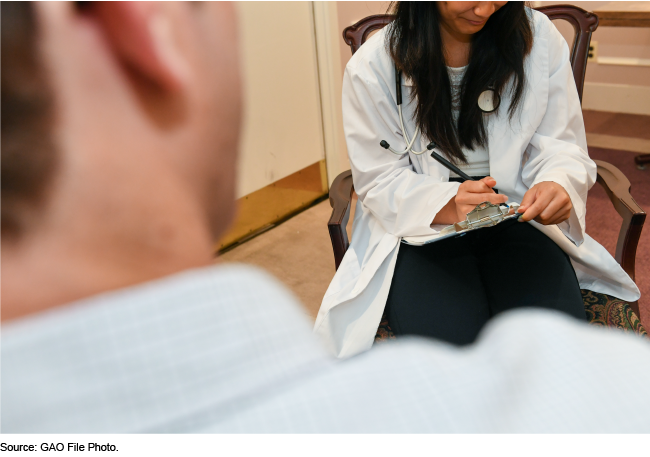Survivors of Childhood Cancer: Factors Affecting Access to Follow-up Care
Fast Facts
The 5-year survival rate for childhood cancer is about 86% as of the mid-2010s. But childhood cancer survivors—those diagnosed from ages 0-19—may face developmental problems, heart conditions, or subsequent cancers requiring follow-up care throughout their lives. Such care includes medical treatments, counseling, and palliative care from primary providers and specialists.
We found factors that affect access to follow-up care:
affordability—survivors may have difficulty paying for care
knowledge—survivors and health care providers must know what care is needed
proximity to care—long-distance travel to clinics may prevent access

Highlights
What GAO Found
Stakeholders GAO interviewed and studies GAO reviewed identified three factors that affect access to follow-up care for childhood cancer survivors—individuals of any age who were diagnosed with cancer from ages 0 through 19. These factors are care affordability, survivors' and health care providers' knowledge of appropriate care, and proximity to care. Childhood cancer survivors need access to follow-up care over time for serious health effects known as late effects—such as developmental problems, heart conditions, and subsequent cancers—which result from their original cancer and its treatment.
- Affordability: Survivors of childhood cancer may have difficulty paying for follow-up care, which can affect their access to this care. For example, one study found that survivors were significantly more likely to have difficulty paying medical bills and delay medical care due to affordability concerns when compared to individuals with no history of cancer.
- Knowledge: Survivors' access to appropriate follow-up care for late effects of childhood cancer can depend on both survivors' and providers' knowledge about such care, which can affect access in various ways, according to stakeholders GAO interviewed and studies GAO reviewed:
- Some survivors may have been treated for cancer at an early age and may have limited awareness of the need for follow- up care.
- Some primary or specialty care providers may not be knowledgeable about guidelines for appropriate follow-up care, which can affect whether a survivor receives recommended treatment. Follow-up care may include psychosocial care (e.g., counseling), and palliative care (e.g., pain management).
- Proximity: Survivors may have difficulty reaching appropriate care settings. Stakeholders GAO interviewed and studies GAO reviewed noted that childhood cancer survivors may have to travel long distances to receive follow-up care from multidisciplinary outpatient clinics—referred to as childhood cancer survivorship clinics. The lack of proximity may make it particularly difficult for survivors with limited financial resources to adhere to recommended follow-up care.
The National Cancer Institute (NCI) and the Centers for Disease Control and Prevention (CDC)—agencies within the Department of Health and Human Services (HHS) that conduct activities specific to childhood cancer survivors, including research about access to care—have taken steps to implement three provisions in the Childhood Cancer Survivorship, Treatment, Access, and Research Act of 2018 (Childhood Cancer STAR Act) relevant to access to care for survivors. For example, CDC has awarded a contract to develop software to improve the collection of information on individuals with childhood cancer, and NCI has funded three research projects focused on interventions aimed at addressing adverse outcomes among childhood cancer survivors. NCI has also funded research to study the health status and use of follow-up services of 2,000 young adult survivors.
Why GAO Did This Study
Stakeholders have raised questions about the ability of childhood cancer survivors to access needed follow-up care. According to the most recent data available, approximately 465,000 childhood cancer survivors—children, adolescents, and adults—were alive in the United States as of January 1, 2017. Although the 5-year survival rate for childhood cancer has increased from about 62 percent in the mid-1970s to about 86 percent in the mid-2010s, childhood cancer survivors may face late effects, which could require follow-up care across multiple stages of their lives.
The conference report accompanying Public Law 115-245 included a provision for GAO to report on barriers to obtaining medical care for childhood cancer survivors, including psychosocial services and palliative care. This report identifies factors reported to affect access to follow-up care for this population.
GAO spoke with officials from NCI and CDC and interviewed stakeholders such as providers who care for childhood cancer survivors, professional associations, and advocacy groups. Additionally, GAO reviewed peer-reviewed studies related to access to care for survivors, outcomes of treatment they may receive, and factors that may affect their access to follow-up care. To supplement this work, GAO reviewed the status of selected HHS activities to support access to care for childhood cancer survivors, including steps taken to implement selected provisions in the Childhood Cancer STAR Act.
GAO provided a draft of this report to HHS for review and comment. HHS provided technical comments, which GAO incorporated as appropriate.
For more information, contact Jessica Farb at (202) 512-7114 or FarbJ@gao.gov.
